Bruce, George (McKechnie Section 4)
See also Sections Five and Six and Houghton and Bruce in this Section
A silhouette artist and miniature painter recorded by Jackson (Dictionary), but not in any earlier publication (surprisingly, since Bruce’s work has been known to collectors for many years).
Apart from a short period spent in Glasgow, we have no evidence that Bruce worked anywhere except in Edinburgh. He is first mentioned in the city records in 1793-94; he and Samuel Houghton (q.v.) are listed jointly as profile-painters at 31 Bridge Street. As we know from Bruce's trade labels, in use after Houghton's death, he was certainly the latters pupil; bearing in mind that Bruce was still in practice in 1847, we might guess that he began work as a pupil of Houghton, probably while a young man, c. 1791. He may therefore have been born in the early or mid-1770s. Entries in the Edinburgh and Leith Post Office Directories for 1794-95, 1795-96 and 1796-97 list Houghton and Bruce in partnership 'at the head of Anchor Close, Edinburgh'. The partnership cannot have lasted more than three years (this accounts for the paucity of work bearing the joint names of the two artistes see Houghton and Bruce) and was terminated by Houghton's death in 1796.
In January 1797 Bruce married Houghton's widow. The Edinburgh Marriage Register 1751-1800 gives the following entry: 'Bruce, George, Miniature Painter, and Mrs. Agnes Caichen, both in High Church P[arish], relict of Samuel Houghton, Jan. 7th., 1797.’ The reference to Mrs Houghton by her maiden name may indicate that Houghton had been dead for some month; alternatively, it might have been customary in Edinburgh at that time for a widow to revert to her maiden name immediately after her husband's death. Her father, John Caichen (or Caitchen) was a carver (presumably in wood), as we know from an entry (18 October 1841) in the Roll of Edinburgh Burgesses 1761-1841: 'Bruce, George, Miniature Painter, B[urgessl and G[uildbrother) by right of w[ife] Agnes. Daughter of John Caitchen. Carver.’ Agnes Bruce was probably older than her husband. She must have borne him at least one son, for in the Edinburgh and Leith Post Office Directories for 1846 and 1847 he is listed as ‘George Bruce, Senr.’, which implies the existence of a son of the same name.
Bruce worked in Edinburgh for more than fifty years. The work span of John Miers, including the period spent at his London studio, covered a period of nearly forty years, but, although there are many extant profiles bearing Miers's name, the work of Bruce, who was in practice for more than ten years longer, is comparatively rare. There are probably many unrecorded examples in private ownership in Scotland. In all directory references Bruce is described as a miniature painter, and during his later vears he must have painted more miniatures in colour than black profiles. Coloured sketches are mentioned on one trade label, as are 'Miniatures from three to five guineas'. Nevertheless, Bruce's work in colour is very sparselv recorded (see Section Six).
The following summarv of entries from the Edinburgh and Leith Post Office Directories, covering Bruce's career in Edinburgh, will enable the reader to date any examples bearing the addresses mentioned. From 1798 until 1845 Bruce is listed as 'Bruce, George, Miniature Painter' at the following addresses; 1798-1801, 'Head of Stevenlaw's Close'; 1803, '16, St. Andrew St.'; 1804-05, '24, Catherine Street'; 1805-07, '3, Greenside Street'; 1807-15, '4 Greenside Street'; 1815-18, '13, Galton Street'; 1818-21, '8, Calton Street'; 1821-25, Stevenlaw's Close'; 1825-26, '31, Broughton Street'; 1826-33, '3 Elder Street'; 1833-38, '3, Bowling Green Street Leith'; 1838-41 'S. Junction St., Leith'; 1841-45, 'London Row, Leith'. The entries for 1845-47 list the artist as 'Bruce, George, Senr, Miniature Painter, London Row, Leith'.
Apart from his work as a profilist and miniature painter, Bruce (notes Jackson) worked as a jeweller and frame-maker. Jackson mentions that he advertised his services in these capacities in news-sheets and on the reverses of his portraits and on his trade labels, and she quotes the following announcement:
Striking Profile Shades in miniature executed on a peculiar plan by George Bruce, pupil of the late celebrated Mr. Houghton. Who respectfully informs the Public that he purposes to stage with Mr. Moffat, where he will cake the Shades of such that are pleased to come to his Room.
He humbly solicits all who wish to procure accurate Likenesses and attends from 10 in the morning to 3 in the afternoon, until 7 in the evening.
Time of sitting three minutes.
The Profiles may be framed in a new Style of Elegance, or reduced on ivory so small as to set in rings, pins, bracelets, lockets, &c. He expects no money if the resemblance is not judged to be perfectly exact.
Since Jackson adds, immediately after this excerpt, `such labels are on the backs of two portraits, all-black on plaster, owned by Mr Malcolm Laing', the excerpt is presumably from a trade label of uncertain date (Trade Label No. 1). The Edinburgh and Leith Post Office Directories contain the following entry for the years 1806-1808: `Moffat, William, Printer and Stationer, 95, Nicolson Street,' but it seems doubtful that William Moffat was the man who collaborated with Bruce, and there appears to be no reference in contemporary records or newspapers to the 'Mr Moffat' with whom we are concerned.
As I have mentioned, Bruce paid a visit to Glasgow (see Trade Label No. 2, below), and worked in Trongate for a few weeks. This visit probably occurred not long after Houghton's death in 1796.
As directory entries for Bruce (which had appeared with almost unbroken regularity for nearly fifty years) cease in 1847, it seems likely that he died (presumably in Edinburgh) in 1847 or 1848.
Since labelled or inscribed portraits which are certainly Bruce's work range widely in date, they naturally show a corresponding degree of change in style.
Bruce painted well in black, good transparency work being more evident on his earlier examples than on those dating from later years up to 1820. As he was taught by Houghton, Bruce painted hair in a manner more similar to Houghton's than to that of his contemporary John Miers (see the magnification photographs in this Section).
Shirt-frills were worn by men during most of the period when Bruce was painting black profiles. His usual method of rendering these was by means of a series of three or four small dark ‘funnels', indicating the part of the frill which is in deepest shadow. Another method (also apparent on examples bearing the joint label of Houghton and Bruce) was to use many lines of neat parallel hatching, also resembling funnels, though less markedly. The artist seems to have used this method concurrently with the first, for two examples (painted about twelve years apart) show it.
A conspicuous feature of men's clothing as shown on Bruce's profiles is the small size of the buttons on frocks and coats; this accords with the fashion of the 1790s, the period when Bruce probably began his career.
The bust-line on Bruce's work is almost always long and plunging. On some later silhouettes (especially those dating from 1810-20) several separate lines are shown beneath the bust-line, following the swooping lines of the finish.
Bruce painted few silhouettes after c. 1820. These later examples are painted in less detail than those of, for instance, John Field, who was painting black profiles on plaster at John Miers's studio at the same period. Indoor caps worn by women, and hair detail, are not painted with quite the same elegance as is seen on Field's work.
Bruce's pre-1800 silhouettes are usually seen in oval hammered brass frames under slightly convex glass; I have seen no examples framed in pearwood. After 1800, Bruce, like many other artists, adopted papier mâché frames. At this stage he painted some silhouettes on fairly large plaster slabs (measuring perhaps 33/4 x 3 in., as opposed to the more fre-quently used size of 31/2 x 23/4 in.), and usually covered them with convex glass.
One silhouette in the Victoria and Albert 1239 Museum, London, previously ascribed to Miers, seems to me to be undoubtedly by Bruce. It shows all the stylistic features which I have mentioned. Its attribution to Bruce is further strengthened by the trade label on the back of a frame-maker from Glasgow: Finlay, 40 Buchanan Street. Since the sitter wears the à la conseilleur hair-style (not often worn by the young and fashionable after c. 1792-93), it may in fact be a product of the Houghton and Bruce partnership.
I have listed four trade labels of Bruce, with the proviso that the existence of No. 1 is conjectural and that No. 4 exists in different versions (all handwritten and all similar in general design) with different addresses.
I have quoted the announcement, recorded by Jackson, which we can assume to have appeared on a trade label (No. 1).
Trade Label No. 2 (illustrated) was used during Bruce's short stay in Glasgow (mentioned above), probably in 1796. Some of the text is missing because the label has been cut to fit an oval brass frame. It reads as follows:
STRIKING LIKENESSES
SHADES IN MINIATURE
EXECUTED ON A PECULIAR PLAN
GEORGE BRUCE
PUPIL OF THE LATE CELEBRATED
Mr. HOUGHTON
Respectfully informs the Public, that he purposes to stay a few Weeks — he will take the Shades of such as are pleased to employ him at his Lodgings, Trongate, and humbly solicits all who wish to have their Friends and Families, to take the earliest opportunity.
Performances are exhibited at his Apartments, where he attends — till three in the Afternoons, and from Five to Seven in the evening.
Time of Sitting, Five Minutes
— frames Bracelets, Lockets, &c.
In a New Style of Elegance
Trade Label No. 3 was used 1815-18, the years during which Bruce worked at the address mentioned:
Miniature and Profile Painting
MR. BRUCE
After more than twenty years practising as a Miniature and PROFILE PAINTER in the City and Country, returns grateful thanks to the Nobility, Gentry, and Public for their kind and Liberal Patronage and humbly solicits a continuance of their favour. After all the attempts at Profile Painting, Profile Clipping, &c., (and many and wonderful have been these attempts), he begs and humbly waits the Inspection of a judicious Public, flattering himself, that upon comparison, his Profiles will be found infinitely superior, both in accuracy of Resemblance and manner of Finishing, to any other ever exhibited in this Country, either painted on ivory for Lockets, &c., or on beautiful Plaster of Paris for Framing, a composition better adapted for correct outlines, and for elegance of style than any other attempted by the inaccurate aid of the fluctuating Physiognotrace.
Profiles painted from 5s. to 10s. 6d. — Coloured sketches on card or paper from 6s. 6d. to one guinea — and miniatures from three to five guineas.
No. 13, Calton Street, opposite the Black Bull.
Oliver and Boyd, Printers.
The variants of Trade Label No. 4 were used at different periods from 1805 until 1821, and further variants might corne to light. The illustrated example (used 1818-21) reads as follows:
George Bruce
Miniature and Profile
Painter
8, Calton Street
Edinburgh
Confusingly, some silhouettes, dated apparently in a contemporary hand, bear addresses which do not coincide with the relevant dates in the directory lists. All the surviving versions of Trade Label No. 4, however, are darkened with age and consequently difficult to read accurately.
Ills. 1239-1230, 1420, 1436-1438
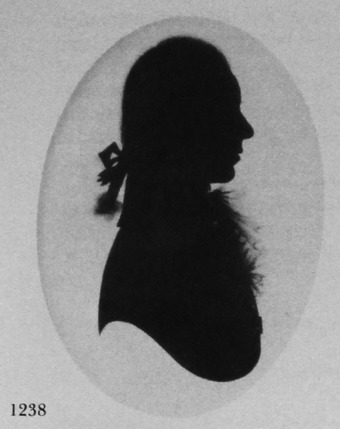
Unknown man
Silhouette painted on plaster
1796
3 x 2 ½ in./77 x 64mm.
Trade Label No. 2
Frame: oval, hammered brass
Painted in Glasgow.
M. A. H. Christie collection
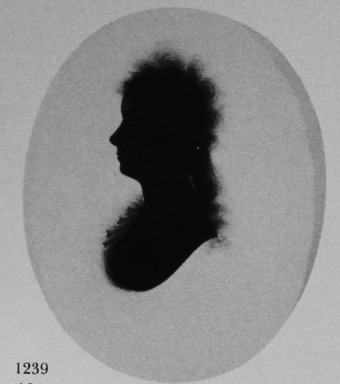
Unknown girl
Silhouette painted on plaster
c. 1796
3 ¼ x 2 ½ in./83 x 64mm.
Frame: oval, hammered brass
Previously ascribed to John Miers, but undoubtedly by Bruce. The frame bears on the reverse the trade label of the frame-maker, Finlay, of 40 Buchanan Street, Glasgow.
Crown Copyright. Victoria and Albert Museum, No. P 157. 1922
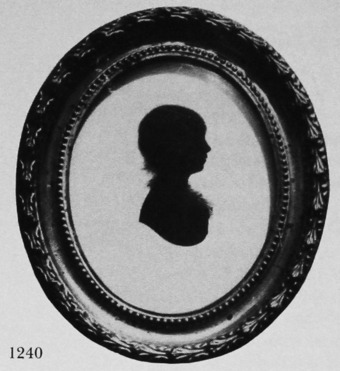
Master Duncan
Silhouette painted on plaster
c. 1798-1805
3 ¼ x 2 ½ in./83 x 64mm.
Frame: oval, hammered brass
Attributed to Bruce on stylistic grounds.
Peggy Hickman collection
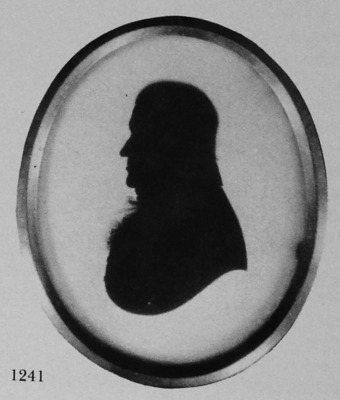
R. Johnson the elder
Silhouette painted on plaster
30 December 1806
3 3/8 x 2 5/8 in./86 x 67mm.
Trade Label No. 4 (address at 8 Calton Street)
Frame: papier mâché
The trade label was used later (1818-21) that the date inscribed on the silhouette.
Author’s collection
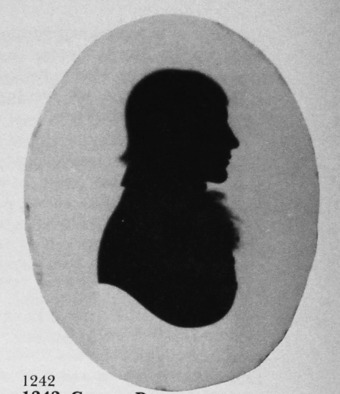
R. Johnson the younger
Silhouette painted on plaster
1806
3 3/8 x 2 5/8 in./86 x 67mm.
Frame: papier mâché
Though unlabelled, undoubtedly Bruce’s work. The sitter was the son of the sitter of the silhouette shown in 1241. On the back of the plaster Bruce wrote the large size of frame (6 ½ x 5 ½ in.) which he required.
Author’s collection
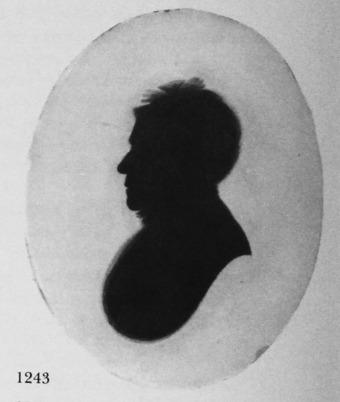
Mrs Baildon
Silhouette painted on plaster
1810
3 ¾ x 3in./96 x 77mm.
Trade Label No. 4 (address at ‘4 Grienside Street’)
Frame: papier mâché
Author’s collection
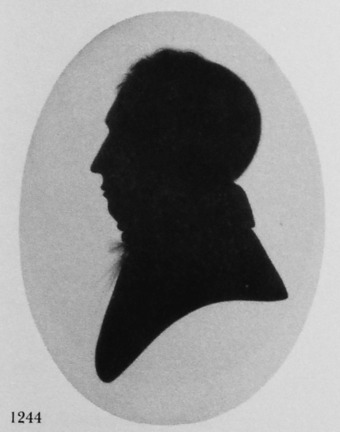
Unknown man
Silhouette painted on plaster
c. 1812
3 ½ x 2 ¾ in./90 x 70mm.
Trade Label No. 4 (address at ‘4 Greinside Street’)
Frame: papier mâché
M. A .H. Christie collection
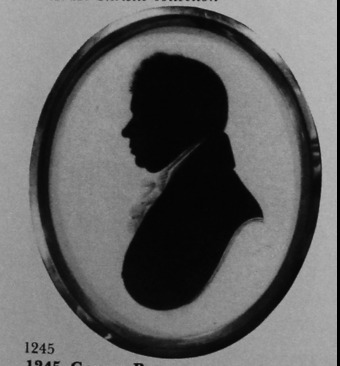
Unknown man
Silhouette painted on plaster
1812-15
3 ¼ x 2 ½ in./83 x 64mm.
Frame: papier mâché
Though unlabelled, this silhouette can safely be ascribed to Bruce; the bust-line is typical, and another silhouette in the M. A. H. Christie collection, labelled ‘Houghton and Bruce’, shows a sitter wearing a shirt-frill painted in the same manner.
The frame bears the label of a Nottingham frame-maker, and may not be original.
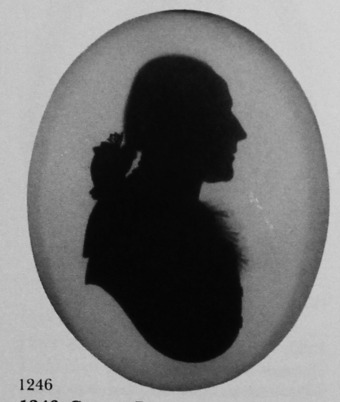
Unknown man
Silhouette painted on plaster
1815-18
3 ½ x 2 ¾ in./90 x 70mm.
Trade Label No. 3
Frame: papier mâché
The sitter’s costume suggests that this silhouette was not painted from life, but was copied from an earlier silhouette (possibly by Samuel Houghton).
J. A. Pollak collection
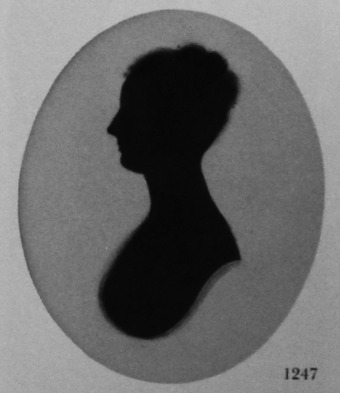
Unknown woman
Silhouette painted on plaster
1815-18
3 ½ x 2 ¾ in./83 x 58mm.
Trade Label No. 3
Frame: papier mâché
D. S. Patton collection
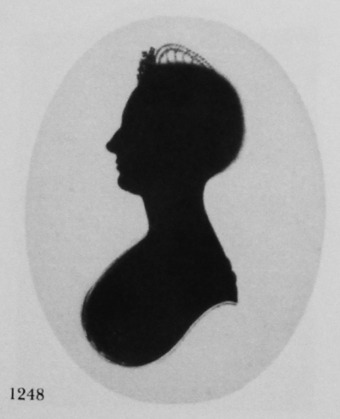
Unknown woman
Silhouette painted on plaster
1815-18
3 ¼ x 2 ¾ in./83 x 70mm.
Trade Label No. 3
Frame: papier mâché
M. A. H. Christie collection
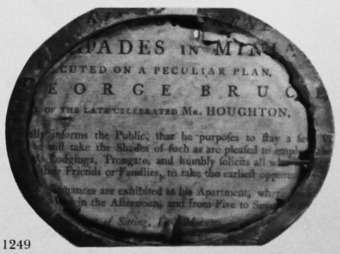
Trade Label No. 2 of George Bruce, from the reverse of the silhouette illustrated in 1238.
M. A. H. Christie collection
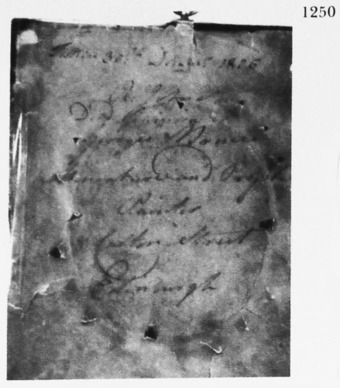
Trade Label No. 4 (address at 8 Calton Street) of George Bruce, from the reverse of the silhouette illustrated in 1241.
Author’s collection
Detail
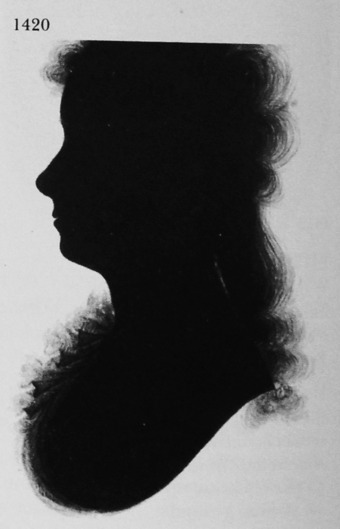
The à la conseilleur hair-style.
Detail from a silhouette of a woman by George Bruce. (Compare also the treatment of the frill with the artist’s similar treatment of a man’s shirt-frill in 1436). (1239)
Crown Copyright. Victoria and Albert Museum, No. P 157-1922
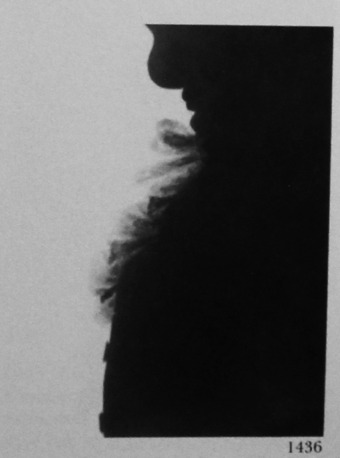
Shirt-frill.
Detail from a silhouette of a man by George Bruce, showing the triangular dark ‘funnels’ characteristic of Bruce’s style of painting a shirt-frill on plaster. The buttons (typically) are small. (1241)
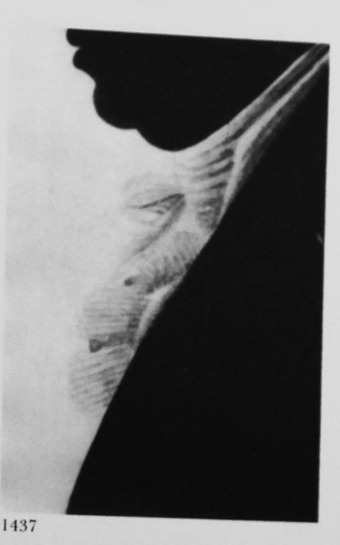
Shirt-frill. Detail from a silhouette of a man by George Bruce. This style of rendering a shirt-frill can also be seen on silhouettes bearing the Houghton and Bruce trade label. (1245)
Present location unknown
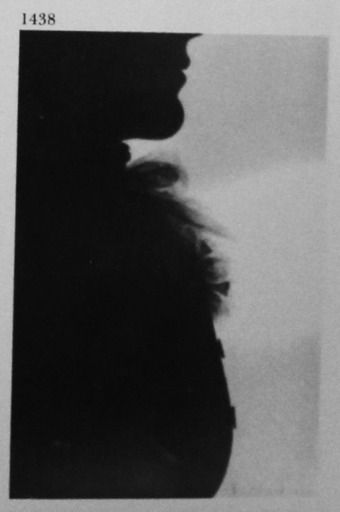
Shirt-frill. Detail from a silhouette of a man by George Bruce. The treatment is similar to that shown in 1436. Note the rendering of the ends of the cravat ties. (1242)
